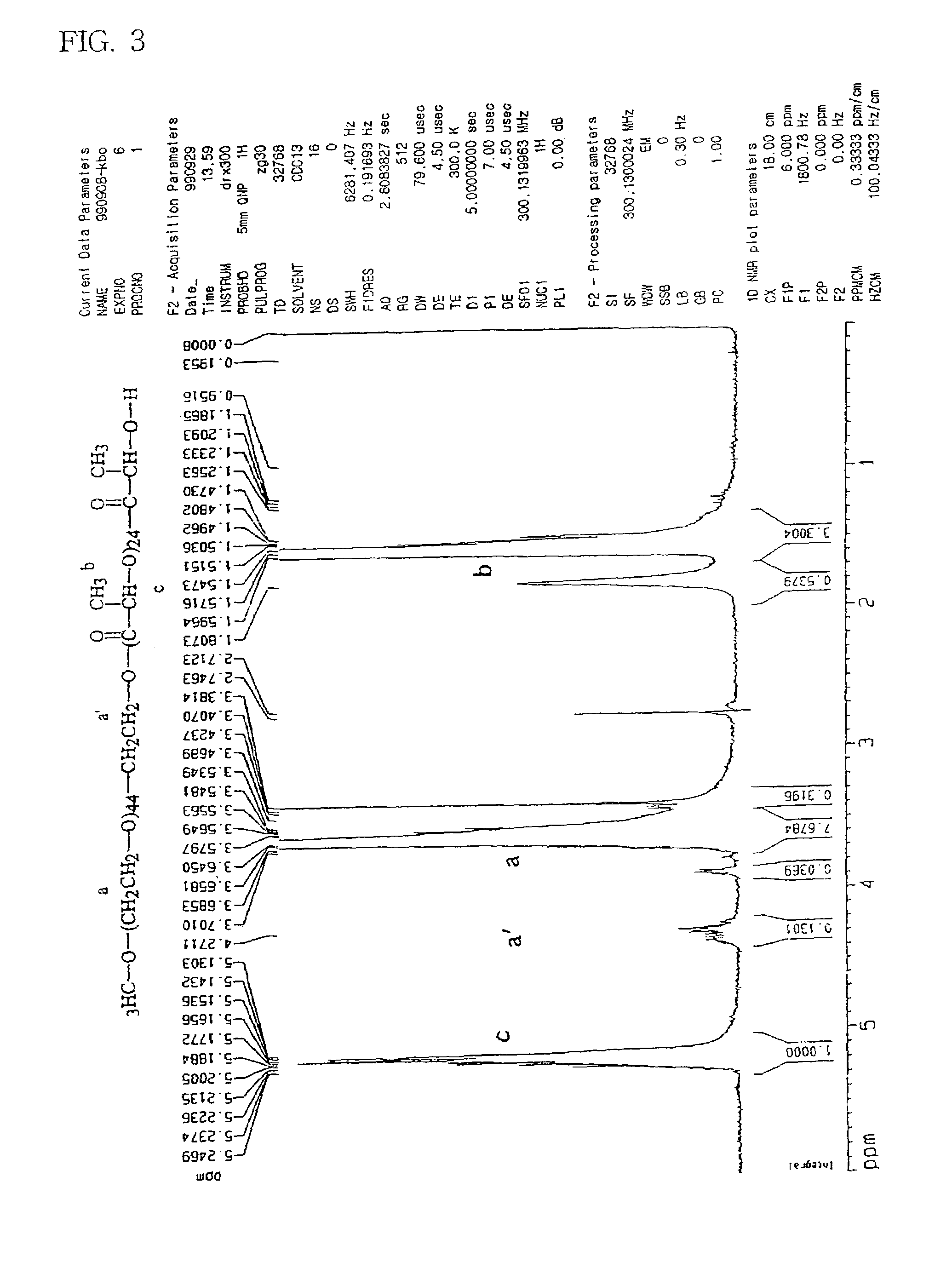Stable polymeric micelle-type drug composition and method for the preparation thereof
a micelle-type, stable technology, applied in the direction of drug compositions, microcapsules, powder delivery, etc., can solve the problems of hydrophobic drug precipitation, hampered above-methods, and most surfactants are relatively toxic, so as to improve bioavailability
- Summary
- Abstract
- Description
- Claims
- Application Information
AI Technical Summary
Benefits of technology
Problems solved by technology
Method used
Image
Examples
preparation example 1a
A diblock copolymer of monomethoxy polyethylene glycol and polylactide having a benzoyloxy terminal group. (mPEG—PLA—Bz)
[0061]25 grams of monomethoxy polyethylene glycol (mPEG with a molecular weight of 2,000) and DL-lactide which was recrystallized from ethyl acetate, and 0.25 g of stannous octoate which was dissolved in 5 mL toluene, were added to a reactor equipped with a mechanical stirrer and a distillation set. Excess toluene was evaporated at 120° C. The polymerization reaction was carried out under vacuum (25 mmHg) for 6 hours. The vacuum was released and 50 mL benzoyl chloride was added to cause substitution of the hydrogen atom of the terminal hydroxyl group by a benzoyl group. The reaction mixture was then agitated for 5 hours at 100° C. The reaction product was dissolved in chloroform and poured into cold diethyl ether (4° C.) to precipitate the polymer. The precipitated polymer was washed twice with diethyl ether and dried under vacuum (0.1 mmHg) for 24 hours. The molec...
preparation example 1b
A diblock copolymer of monomethoxy polyethylene glycol and polyactide having a benzoyloxy terminal group (mPEG—PLA—Bz)
[0062]25 grams monomethoxy polyethylene glycol (mPEG with a molecular weight of 2,000) and DL-lactide which was recrystallized from ethyl acetate, and 0.25 g of stannous octoate which was dissolved in toluene (5 mL), were added to a reactor equipped with a mechanical stirrer and a distillation set. Excess toluene was evaporated at 120° C. The polymerization reaction was carried out under vacuum (25 mmHg) for 6 hours. The reaction product was dissolved in chloroform and poured into cold diethyl ether (4° C.) to precipitate the polymer. The precipitated polymer (mPEG—PLA) was washed twice with diethyl ether and dried under vacuum (0.1 mmHg) for 24 hours.
[0063]In order to substitute the hydrogen atom of the terminal hydroxyl group with a benzoyl group, the above-obtained polymer (mPEG—PLA) (30 g) and benzoyl chloride (60 mL) were added into a reactor and agitated for 5 ...
preparation example 2
A diblock copolymer of monomethoxy polyethylene glycol and polylactide having an acetyloxy terminal group
[0064]A diblock copolymer (mPEG—PLA—Ac) was prepared using acetyl chloride (50 mL) instead of benzoyl chloride, added to cause substitution of the hydrogen atom of the terminal hydroxyl group by a acetyl group. The molecular weight was determined by the same procedure described in preparation Example 1a. The NMR spectrum is as shown in FIG. 2.
PUM
| Property | Measurement | Unit |
|---|---|---|
| molecular weight | aaaaa | aaaaa |
| solubility | aaaaa | aaaaa |
| concentration | aaaaa | aaaaa |
Abstract
Description
Claims
Application Information
 Login to View More
Login to View More - R&D
- Intellectual Property
- Life Sciences
- Materials
- Tech Scout
- Unparalleled Data Quality
- Higher Quality Content
- 60% Fewer Hallucinations
Browse by: Latest US Patents, China's latest patents, Technical Efficacy Thesaurus, Application Domain, Technology Topic, Popular Technical Reports.
© 2025 PatSnap. All rights reserved.Legal|Privacy policy|Modern Slavery Act Transparency Statement|Sitemap|About US| Contact US: help@patsnap.com



